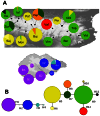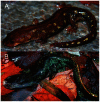Integrative phylogeography of Calotriton newts (Amphibia, Salamandridae), with special remarks on the conservation of the endangered Montseny brook newt (Calotriton arnoldi)
- PMID: 23750201
- PMCID: PMC3672179
- DOI: 10.1371/journal.pone.0062542
Integrative phylogeography of Calotriton newts (Amphibia, Salamandridae), with special remarks on the conservation of the endangered Montseny brook newt (Calotriton arnoldi)
Abstract
The genus Calotriton includes two species of newts highly adapted to live in cold and fast-flowing mountain springs. The Pyrenean brook newt (Calotriton asper), restricted to the Pyrenean region, and the Montseny brook newt (Calotriton arnoldi), endemic to the Montseny massif and one of the most endangered amphibian species in Europe. In the present manuscript, we use an integrative approach including species distribution modeling (SDM), molecular analyses of mitochondrial and nuclear DNA sequence data and morphology to unravel the historical processes that have contributed to shaping the biogeography and genetic structure of the genus Calotriton, with special emphasis on the conservation of C. arnoldi. The results of the molecular analyses confirm that, despite having originated recently, being ecologically similar and geographically very close, there is no signal of hybridization between C. asper and C. arnoldi. SDM results suggest that tough environmental conditions on mountains tops during glacial periods, together with subsequent warmer periods could have prevented the contact between the two species. Within the critically endangered C. arnoldi, a high genetic structure is revealed despite its extremely small distribution range compared to C. asper. Haplotype networks, AMOVA and SAMOVA analyses suggest that two distinct groups of populations can be clearly differentiated with absence of gene flow. This is in concordance with morphological differentiation and correlates with its geographical distribution, as the two groups are situated on the eastern and western sides of a river valley that acts as a barrier. The genetic and morphological results are highly important for the ongoing conservation program of C. arnoldi and strongly justify the management of this species into at least two independent evolutionary significant units (eastern and western sectors) to guarantee the long-term population viability.
Conflict of interest statement
Figures






References
-
- Lowe JJ, Walker MJ (1997) Reconstructing quaternary environments: Longman London.
-
- Hewitt G (2011) Quaternary phylogeography: the roots of hybrid zones. Genetica 139: 617–638. - PubMed
-
- Hewitt GM (1996) Some genetic consequences of ice ages, and their role in divergence and speciation. Biological Journal of the Linnean Society 58: 247–276.
-
- Taberlet P, Fumagalli L, Wust-Saucy A-G, Cosson J-F (1998) Comparative phylogeography and postglacial colonization routes in Europe. Molecular Ecology 7: 453–464. - PubMed
Publication types
MeSH terms
LinkOut - more resources
Full Text Sources
Other Literature Sources

